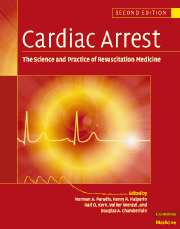Book contents
- Frontmatter
- Contents
- List of contributors
- Foreword
- Preface
- Part I Introduction
- Part II Basic science
- Part III The pathophysiology of global ischemia and reperfusion
- Part IV Therapy of sudden death
- 23 Prevention of sudden cardiac death
- 24 Sequence of therapies during resuscitation: application of CPR
- 25 Transthoracic defibrillation
- 26 Automated external defibrillators
- 27 Public access defibrillation
- 28 The physiology of ventilation during cardiac arrest and other low blood flow states
- 29 Airway techniques and airway devices
- 30 Manual cardiopulmonary resuscitation techniques
- 31 Mechanical devices for cardiopulmonary resuscitation
- 32 Invasive reperfusion techniques
- 33 Routes of drug administration
- 34 Adrenergic agonists
- 35 Vasopressin and other non-adrenergic vasopressors
- 36 Antiarrhythmic therapy during cardiac arrest and resuscitation
- 37 Acid–base considerations and buffer therapy
- 38 Cardiac arrest resuscitation monitoring
- 39 Special considerations in the therapy of non-fibrillatory cardiac arrest
- 40 Cardiocerebral resuscitation: a new approach to out-of-hospital cardiac arrest
- 41 Thrombolysis during resuscitation from cardiac arrest
- 42 Percutaneous coronary intervention (PCI) after successful reestablishment of spontaneous circulation and during cardiopulmonary resuscitation
- 43 Emergency medical services systems and out-of-hospital cardiac arrest
- 44 In-hospital resuscitation
- 45 Complications of CPR
- 46 Bringing it all together: state-of-the-art therapy for cardiac arrest
- Part V Postresuscitation disease and its care
- Part VI Special resuscitation circumstances
- Part VII Special issues in resuscitation
- Index
36 - Antiarrhythmic therapy during cardiac arrest and resuscitation
from Part IV - Therapy of sudden death
Published online by Cambridge University Press: 06 January 2010
- Frontmatter
- Contents
- List of contributors
- Foreword
- Preface
- Part I Introduction
- Part II Basic science
- Part III The pathophysiology of global ischemia and reperfusion
- Part IV Therapy of sudden death
- 23 Prevention of sudden cardiac death
- 24 Sequence of therapies during resuscitation: application of CPR
- 25 Transthoracic defibrillation
- 26 Automated external defibrillators
- 27 Public access defibrillation
- 28 The physiology of ventilation during cardiac arrest and other low blood flow states
- 29 Airway techniques and airway devices
- 30 Manual cardiopulmonary resuscitation techniques
- 31 Mechanical devices for cardiopulmonary resuscitation
- 32 Invasive reperfusion techniques
- 33 Routes of drug administration
- 34 Adrenergic agonists
- 35 Vasopressin and other non-adrenergic vasopressors
- 36 Antiarrhythmic therapy during cardiac arrest and resuscitation
- 37 Acid–base considerations and buffer therapy
- 38 Cardiac arrest resuscitation monitoring
- 39 Special considerations in the therapy of non-fibrillatory cardiac arrest
- 40 Cardiocerebral resuscitation: a new approach to out-of-hospital cardiac arrest
- 41 Thrombolysis during resuscitation from cardiac arrest
- 42 Percutaneous coronary intervention (PCI) after successful reestablishment of spontaneous circulation and during cardiopulmonary resuscitation
- 43 Emergency medical services systems and out-of-hospital cardiac arrest
- 44 In-hospital resuscitation
- 45 Complications of CPR
- 46 Bringing it all together: state-of-the-art therapy for cardiac arrest
- Part V Postresuscitation disease and its care
- Part VI Special resuscitation circumstances
- Part VII Special issues in resuscitation
- Index
Summary
Most cases of sudden cardiac death (SCD) are due to malignant ventricular tachyarrhythmias, such as ventricular tachycardia (VT) and ventricular fibrillation (VF)(see Fig. 36.1). Both VF and pulseless VT require defibrillation as definitive therapy. If these or other arrhythmias persist despite basic life support and defibrillation, the current international advanced cardiac life support guidelines (ILCOR 2005) recommend administration of pharmacologic agents to help stabilize rhythm and restore cardiac output.
The pathophysiologic substrate of cardiac arrest: therapeutic implications
The pathophysiology of sudden cardiac death is relevant to both acute and long-term management. In most instances, the underlying cardiac pathology is ischemia and coronary artery disease. For instance, Liberthson and coworkers reported that 81% of a series of SCD victims had significant coronary artery disease. In another series, up to 50% of the victims of out-of-hospital cardiac arrest had suffered a recent acute myocardial infarction. Although the majority have a coronary disease etiology, numerous other pathologies can be involved in the genesis of sudden cardiac death, such as ventricular hypertrophy, cardiomyopathies, congenital disorders of ion channels (“channelopathies”), but also massive pulmonary embolism, as well as coronary dissection, and coronary inflammation or embolism to the coronary arteries. Froma clinical perspective, it is appropriate to assume that the cause of sudden death is coronary artery disease unless circumstances suggest otherwise. Although the creatine kinase (CK) and its MB fraction may not be diagnostic of acute myocardial ischemia, cardiac troponins can identify myocardial ischemic damage and thus prompt invasive coronary studies, which may make longterm antiarrhythmic treatment irrelevant.
- Type
- Chapter
- Information
- Cardiac ArrestThe Science and Practice of Resuscitation Medicine, pp. 667 - 673Publisher: Cambridge University PressPrint publication year: 2007



